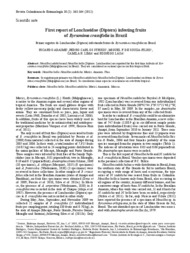First report of Lonchaeidae (Diptera) infesting fruits of Byrsonima crassifolia in Brazil.
First report of Lonchaeidae (Diptera) infesting fruits of Byrsonima crassifolia in Brazil.
Author(s): ADAIME, R.; STRIKIS, P. C.; SOUZA-FILHO, M. F. de; LIMA, C. R.; LASA, R.
Summary: Murici, Byrsonima crassifolia (L.) Kunth (Malpighiaceae), is native to the Amazon region and several other regions of tropical America. The fruits are small globose drupes with fleshy yellow mesocarp (pulp) and characteristic flavor and aroma. They are consumed fresh as juice, jam, liquor and sweets (León 1968; Donadio et al. 2002; Lorenzi et al. 2006). In addition, fruits of this species have been widely used in the traditional medicine by its antimicrobial and antidepressant properties (Martínez-Vázquez et al. 1999; Herrera-Ruiz et al. 2011). The only record of fruit flies (Diptera) associated to fruits of B. crassifolia in Brazil was published by Pereira et al. (2008) from material collected in the state of Amapá during 2005 and 2006. In their work, a total number of 7,915 fruits (16.02 kg) was collected in 24 sampling points distributed in the municipalities of Macapá, Mazagão and Porto Grande. Three samples were infested by fruit flies of the family Tephritidae (one in Macapá, 0.01 puparia/fruit; two in Mazagão, 0.10 and 0.15 puparia/fruit). Anastrepha striata Schiner, 1868 (10 specimens), A. obliqua (Macquart, 1835) (8 specimens) and A. fraterculus (Wiedemann, 1830) (3 specimens) were recovered in those collections. In other samples of B. crassifolia collected in the Brazilian Amazon (states of Amapá and Rondônia), no fruit flies specimens were obtained (Deus et al. 2009; Pereira et al. 2010; Silva et al. 2011a). In Mexico, the presence of A. serpentina (Wiedemann, 1830) in B. crassifolia was recorded in the state of Chiapas (Aluja et al. 1987). However, the presence of Lonchaeidae (Diptera) species in B. crassifolia was not recorded in either study.
Publication year: 2012
Types of publication: Journal article
Unit: Embrapa Amapá
Keywords: Amazonia brasileira, Fruta tropical, Mosca das frutas, Murici
Observation
Some of Embrapa's publications are published as ePub files. To read them, use or download one of the following free software options to your computer or mobile device. Android: Google Play Books; IOS: iBooks; Windows and Linux: Calibre.
Access other publications
Access the Agricultural Research Database (BDPA) to consult Embrapa's full library collection and records.
Visit Embrapa Bookstore to purchase books and other publications sold by Embrapa.

